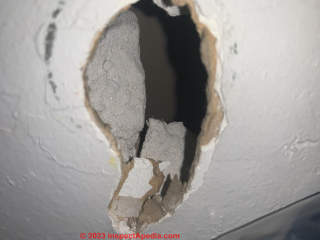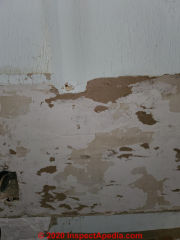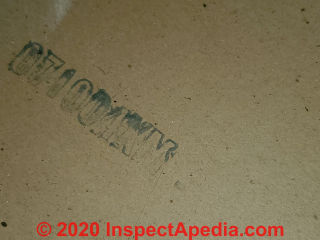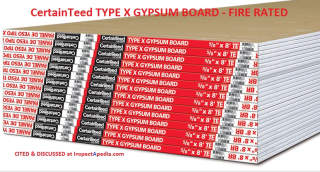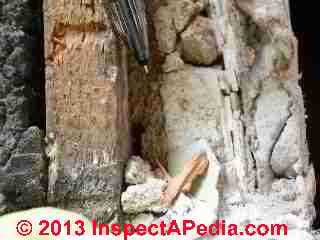 Asbestos Content in Drywall FAQs
Asbestos Content in Drywall FAQs
Q&A on asbestos content in drywall or joint compound
- POST a QUESTION or COMMENT about the level of asbestos found in drywall on walls & ceilings.
Recent questions & answers on the question: does drywall or "sheetrock" contain asbestos?
This article series explains where asbestos is likely to be found in gypsum board or drywall systems, particularly in the taping compound and in skim coats using drywall "mud" that contained asbestos.
InspectAPedia tolerates no conflicts of interest. We have no relationship with advertisers, products, or services discussed at this website.
- Daniel Friedman, Publisher/Editor/Author - See WHO ARE WE?
FAQs on the Asbestos content in Drywall, wallboard or Sheetrock® or in joint compound

Recently-posted questions & answers about asbestos & other materials in gypsum board, drywall, or Sheetrock® panels, posted originally
at ASBESTOS in DRYWALL - be sure to read the advice on that page.
[Click to enlarge any image]
On 2021-12-20 by Inspectapedia Com Moderator
@Jen,
There is no measurable hazard from a 1-2 inch ding in the bottom of drywall, but sure, safest is to install a baseboard trim.
Clean up with damp wiping and if there is a lot of dust, HEPA vacuuming.
It's true that in specific areas certain manufacturers or brands may have been dominant.
But without identifying a specific brand, it's also reasonable to say that by the late 1940s drywall, joint compound, tape, plaster, etc. used in building interiors were pretty much widely distributed across the continental U.S. from the various major manufacturers.
On 2021-12-20 by Jen
New homeowner here...we just bought a house built in 1950 and redone in the 90s. The master bedroom closet has some (3"*1") damage along the base of the wall where there is also a gap between the drywall and the floor. I understand there is a possibility of asbestos in the drywall.
Should we be concerned that this area is creating an asbestos hazard because of the damage to the wall and would fitting molding to the base of the wall be enough to encapsulate any hazard? We had thought of vacuuming the crumbled drywall but were unsure if that would create an exposure where there was none.
Are there certain areas of the US that were more likely to use asbestos drywall, tape, and joint compound? I reside in SLC, UT. Just purchased a home built in 1949 and planning to take down some walls. Wondering if we should get them tested. Thanks!
On 2021-08-31 by inspectapedia.com.moderator
@robert h,
Done, in the article above; both in PDF downloads of research documents and in lists of asbestos-containing products and manufacturers.
On 2021-08-31 by robert h
names of joint compound in 70s with asbestos
On 2021-06-01 by mak.church (mod)
@Kyle, Let me refer to the below article to help with your questions and to encourage you to take necessary precautions with regard to doing it yourself or hiring a professional:
Asbestos Content in Drywall & Joint Compound? https://inspectapedia.com/hazmat/Asbestos-Drywall-Remediation.php#QA
Let us know if you have additional questions.
On 2021-06-01 by Kyle
Just recently had my popcorn ceiling material tested and it came back negative for asbestos. However, the joint compound used on the ceiling tested 1-5%. I was planning on removing the popcorn ceiling myself. I'm concerned removing the popcorn will now disturb the joint compound. Do I now need to seek another alternative such as putting new drywall over top, leaving the ceiling altogether, or hiring proper abatement team? Thanks for all the valuable information!
On 2021-05-31 by inspectapedia.com.moderator (mod)
- source:
U.S. EPA "Protect Your Family from Exposures to Asbestos" - cited in the article above.
On 2021-05-31 by inspectapedia.com.moderator (mod) - how to manage asbestos hazards when drilling or cutting into drywall.
@Michelle,
Thank you for the question on how to manage asbestos hazards when drilling or cutting into drywall.
First, though, Help me understand the question correctly. I read that there is no asbestos in your walls and asbestos-containing popcorn ceiling paint is being removed.
If that's right, why are we concerned about asbestos hazards from cutting holes to mount things to the walls or ceilings?
For other readers:
**IF** your wall or ceiling drywall contains asbestos (which you cannot know without testing), the U.S. EPA recommends that
Asbestos Do's and Don'ts for the Homeowner
Do leave undamaged asbestos-containing materials alone.
Do keep activities to a minimum in any areas having damaged material that may contain asbestos, including limiting children's access to any materials that may contain asbestos.
Do take every precaution to avoid damaging asbestos-containing material.
Do have removal and major repair done by people trained and qualified in handling asbestos.
It is highly recommended that sampling and minor repair also be done by a trained and accredited asbestos professional.
Don't dust, sweep, or vacuum debris that may contain asbestos.
Don't saw, sand, scrape, or drill holes in asbestos-containing materials.
Don't use abrasive pads or brushes on power strippers to strip wax from asbestos flooring. Never use a power stripper on flooring that may contain asbestos.
Don't sand or try to level asbestos flooring or its backing. When asbestos flooring needs replacing install new floor covering over it, if possible.
Don't track material that could contain asbestos through the house. If you cannot avoid walking through the area, have it cleaned with a wet mop. If the material is from a damaged area or if a large area must be cleaned, call an asbestos professional.
In our OPINION (we are not asbestos experts)
- simply installing a nail or screw to mount a picture does not create a measurable asbestos hazard; if that step, in your home, makes a bit of drywall dust, clean it up using HEPA vacuuming and damp wiping.
You can also minimize any possible drywall dust release from any picture hanging fastener installation by first applying a bit of tape, such as masking tape, over the wall area for an inch or so through the center of which the nail or screw will be driven.
- cutting larger openings such as to inspect wall or ceiling cavities for hidden damage, leaks, mold, or to route wires or pipes etc., might indeed create hazardous dust and so should follow the EPA recommendations above.
On 2021-05-30 by Michelle
We recently bought a 1969 house that has a knockdown texture over all the walls. The wall texture and joint compound tested positive for less than 1% asbestos (a point sample test was conducted) and the drywall tested negative. Popcorn ceiling with 3% asbestos is being professionally abated. We plan to not complete any demo work ourselves.
What precautions do you recommend we take for things like anchoring furniture to the walls or hanging heavy items? What questions should we ask tradesmen to ensure they take appropriate precautions when working to protect their health and also ours from any resulting dust (such as electricians drilling holes or drywall repair people patching professionally abated drywall)?
When should an abatement company be hired to work in tandem with other tradesmen (such as the abatement company drilling the holes the electrician needs)? Thank you for your assistance and generosity in sharing this information.
On 2021-04-21 by Anonymous
thank you for response and help
On 2021-04-21 - by (mod) -
@Jena,
"Is it safe to drive a picture nail or screw into asbestos-suspect drywall?"
No worries. Driving a nail or turning in a small screw to hang a photo will not produce a detectable hazard of dust alone, and as the volume of such dust is so miniscule it won't produce a detectable asbestos hazard from the drywall
Thank you for a helpful question.
On 2021-04-21 by Jena
We are buying a house built in 1976 and have been told there is asbestos in the drywall. I know it is safe as long as it is not disturbed. So my question is, can I still nail or drill into the wall to hang photos, etc? Or is that a disturbance that would release the fibers into the home? We don't want to risk exposure to our family. Thank you for your help!
On 2021-04-20 by danjoefriedman (mod) - drywalls Stamp "approved the board of standards CAL 702"
 @John Ban,
@John Ban,
I can't identify that drywall, but based on its age it would be prudent to treat the drywall as well as joint compound used on the walls as presumed to contain asbestos. It's perfectly harmless if left in place and undisturbed; if you face a costly demolition then you might want to have representative samples tested.
By the way it looks as if there may have been leaks, water damage and mold contamination on some of your drywall.
You might want to take a look at HIDDEN MOLD, HOW TO FIND https://inspectapedia.com/mold/Find-Hidden-Mold.php
On 2021-04-20 by John Ban
Hi, bought a house in Long Island and the basement has wallboard. [Image above]
No brand name on the wall board. The house was built in 1952. The boards has a print say approved the board of standards and quotes CAL 702.
Given the age of the house, I'm trying to determine if the board has asbestos in it. Many thx
On 2021-04-10 by Anonymous
@danjoefriedman thank you this is the US. I appreciate your response.
On 2021-04-10 by (mod)
@MW, you don't give the country and city but if you're in the US manufacturers stopped using asbestos in such products in or before products in 1986
On 2021-04-09 by MW
would drywall with a date stamp of December 1989 possibly contain asbestos?
On 2021-03-23 - by (mod) - is there a chance that walls in our 1978 home contained asbestos?
@Mary, Unfortunately nobody can guess at asbestos exposure from drywall from a brief e-text. It's possible that your drywall OR the joint compound used on it contained asbestos, given its age
. If you can find some dust that remains from that work you could have it tested but I'm not sure that the answer is going to give any help now - the horse has run out of the barn, regardless of whether or not her saddlebags of dust contained asbestos.
On 2021-03-23 by Mary
My house was built in 1978. Last year we had a crack in the wall due to a heavy shelf, and my husband repaired it but had to cut a part of the wall off.
We didn't even think about asbestos in the drywall. We had a previous renovation where the popcorn ceiling, floor tiles, carpet, and textured walls were tested for asbestos (all came back negative) but we didn't test the drywall because we weren't knocking down any walls.
That being said, the contractors did pull out cabinets and lights from the wall, so there was a major disturbance. Is there a high chance that the walls contained asbestos? It was a while ago but I just want to see what other people think.
On 2020-04-09 - by (mod) - asbestos & other hazards in 5/8" pink drywall?
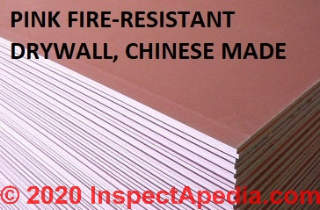 Dustin
Dustin
How interesting; I've not come U.S.-made across pink drywall dust from the 1960s.
However some Chinese and other Asian made drywall is or was pink in color such as drywall from Newswan.com, a Shanghai company and also drywall from Pynwau - possibly a fire-rated drywall product. [shown below]
You'll want to take a look at CHINESE DRYWALL HAZARDS
If you can find any manufacturer's imprints include a photo here (one image per comment) of the drywall edge and another of the imprinting.
On 2020-04-08 2 by Dustin
Hi
I was recently cutting some drywall in my basement that was covering water pipes.
I notified the dust itself was pink, while the backing material was brown. I have not been able to identify a brand on the material but it is 5/8" thick.
The house was built in 68, but haven't encountered much asbestos elsewhere thus far (professionally tested). I suspect the drywall in the laundry was done later
On 2020-03-19 - by (mod) - lab found no asbestos in this ceiling drywall & popcorn ceiling paint
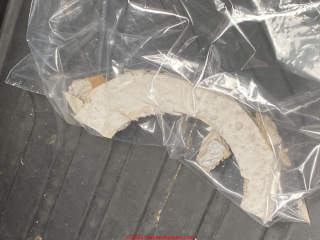 It's possible that your home has no asbestos in its drywall or joint compound, though it was common in many (but not all) such products, particularly the compound.
It's possible that your home has no asbestos in its drywall or joint compound, though it was common in many (but not all) such products, particularly the compound.
The ugly truth is that there is quite a bit of variability in asbestos lab test accuracy depending on the individual sample properties and also on the individual technician and how she prepares the sample and operates the microscope (or other equipment).
In particular what strikes me odd is lab reports that indicate finding extremely small levels of asbestos - such as less than 1%. I suspect people are playing the "CYA" game (cover your "assets") to be on the safe side.
Bottom line:
1. don't panic - that anxiety is bad for your health
2. if a dusty mess has already been made of your drywall then damp wipe, mop, and HEPA vacuum to clean all surfaces
3. wash your hands and avoid crowds or even large groups as the current virus epidemic ( now named severe acute respiratory syndrome coronavirus 2 (SARS-CoV-2) (formerly called HCoV-19) emerged in Wuhan, China, in late 2019) is farm more urgent and more-immediately dangerous than drywall dust
On 2020-03-19 by Jessica
I recently purchased a home built in 1971. It has popcorn ceilings but the popcorn is negative for asbestos, tested twice. The sheetrock man I’ve hired to scrape them didn’t ask about the joint compound.
I tried as best I could to get a sample of tape/compound and found what I THINK is take and compound in a basement closet, but I’m not certain. I also sent a sample from the edge of the ceiling where the wall and ceiling meet.
The lab said they saw no asbestos, which is very shocking and I’m not sure I believe it. I’m questioning if I even got joint compound in my samples. Is it possible my home really doesn’t have asbestos JC?
I am only worried about sanding the ceilings to smooth them out. Pic of my samples.
On 2023-01-19 by InspectApedia Publisher - USG's announcement of lightweight fire-rated gypsum board
Tim found and we provide a copy of USG's announcement of lightweight fire-rated gypsum board
USG INTRODUCES INDUSTRY’S FIRST LIGHTWEIGHT TYPE X BOARD – SHEETROCK® BRAND ULTRALIGHT PANELS FIRECODE® X [PDF] - BusinessWire, retrieved 2023/01/19 original source https://www.businesswire.com/news/home/20110803005965/en/USG-Introduces-Industry%E2%80%99s-First-Lightweight-Type-X-Board-%E2%80%93-SHEETROCK%C2%AE-Brand-UltraLight-Panels-Firecode%C2%AE-X
Excerpt:
USG leads the industry in lightweight gypsum panel technology and is the only manufacturer to offer a portfolio of lightweight products. The company launched the industry’s first lightweight gypsum board – ½-inch SHEETROCK® Brand UltraLight Panels – in July 2010. USG then introduced SHEETROCK® Brand UltraLight Panels FIRECODE® 30, a 5/8-inch board for nonrated and 30-minute fire-rated partitions, in June 2011. Both panels are up to 30 percent lighter than competitive panels. - USG Introduces Industry’s First Lightweight Type X Board – August 03, 2011
Also see USG's
USG SHEETROCK® BRAND ECOSMART PANELS FIRECODE® X Submittal Sheet Data [PDF] (2021) Source: US Gypsum, https://www.usg.com/
On 2023-01-19 by InspectApedia Publisher
@TIM,
Thank you, that's quite helpful. Any documents or links you can suggest? Use my email found via the page top or bottom CONTACT link.
We will add the data that you found as well as what we can find from our own research to this article.
On 2023-01-19 by TIM
@InspectApedia Publisher, Thank you. From my research, it looks like ultralight panels weren't introduced until 2010. If anyone does not agree then I wold appreciate your thoughts. Luckily, it looks like asbestos is not a concern. I was worried.
On 2023-01-18 by InspectApedia Publisher - when was firecode R X UL type ULX sheetrock first distributed?
@TIM,
Thanks, that's a helpful question. Let's both do some research on the history of use and first patents of Fire-code rated R X UL ULX drywall use, and report back here.
For your specific case, what's appropriate now is simply to be sure you've done a thorough dust-cleanup: damp wipe and HEPA vacuum surfaces.
On 2023-01-18 by TIM
Does anyone know when firecode R X UL type ULX sheetrock was first distributed? Had a contractor tear the whole thing out and didn't even think about asbestos.
On 2021-07-28 by inspectapedia.com.moderator
@Kathleen,
There is no sheetrock in your photo. There is fiber board with a thin plaster coating.
I see a small bit of that same material lying flat in the bottom of the opening in the photo.
There's other gray material in the photo inside the opening that I can't make out.
You might try another photo with better lighting.
On 2021-07-28 by Kathleen
@danjoefriedman, could the material on the inside be broken sheet rock?
On 2021-07-27 by danjoefriedman (mod) - fiberboard wall with a thin coat of plaster
@Kathleen,
Your photo shows fiberboard wall with what looks like a thin coat of plaster
See
FIBERBOARD SHEATHING IDENTIFICATION
Also see
SHEATHING, FIBERBOARD ASBESTOS CONTENT
I can't make out what's inside the wall cavity - perhaps cellulose insulation?
On 2021-07-27 by Kathleen
Does this look like asbestos? House built in 1965. My kids accidentally put a hole in the with their door knob and I had no clue our house could potentially have asbestos. I’ve neglected to fix the hole for two years and now and very concerned that it has just been open.
The contents inside have not been distrusted since the hole happened but are my concerns for it being exposed valid? This is in my children’s room. thank you so much for your input.
On 2021-03-25 by danjoefriedman (mod) - Are the fibers in drywall always asbestos?
@Stacy, no, the fibers in drywall are not always asbestosis and in fact they are not usually asbestos. There are many other fibers that may be found in such materials. And as you point out you can't identify an asbestos fiber with the naked eye.
On 2021-03-25 by Stacy
Question about asbestos in drywall, or just drywall in general. Are the fibers in drywall always asbestos?
I know you can’t tell by just looking but there is exposed drywall under the wood finishings for the doors in my house ( you can see the exposed drywall edge when you look through the hole where the lock goes, I literally just found out while cleaning today) you can see the edge of the exposed drywall, and there are white fibers sticking out of the edge and they look plastic like.
I read that it could also be fiberglass? also, was asbestos commonly used in residential drywall? my house was built in the late 70s so it is always a possibility.
On 2020-12-13 by Hannah J Parrish
Nice, I use a similar method, I also like to score the drywall with a shallow cut along the screw lines /studs/seams so it breaks on those scorelines, makes it even easier to puill off each segment.
On 2020-08-27 by (mod) - tape over drywall test cuts pending proper repair
Alonzo
There are a few reasons to tape over test cuts in drywall or "sheetrock" walls until you're ready to make a proper drywall repair by filling, taping over the holes, and re-painting:
1. closing openings in drywall reduces air leaks and the risk of moisture accumulation in walls - reducing the risk of a mold problem
2. reducing air leaks can reduce heating and cooling costs
3. while there is usually no measurable hazard from silica or drywall dust or asbestos from small test cuts properly-made and cleaned-up, taping the openings can provide the health benefit of reduced stress from peace of mind while you wait ford repair.
Watch out: when there is water damage behind drywall you should look carefully for mold contamination: a potentially serious health hazard, and a problem that may involve significant expense: find the mold, remove it and fix its cause.
On 2020-08-27 by Alonzo
Hello, thanks for this very useful website! I had the drywall in the kitchen of my condo (built 1980) inspected for asbestos about a year ago.
To do this, the tester removed half-dollar-size pieces of the wall for testing. It turns out there wasn't any asbestos in the drywall,
so I just left the holes unrepaired as they were near the floor and not very noticeable. Bu I realized there might be other asbestos-containing material inside the walls, like insulation, and
I was wondering if any of that could have gotten into the air, and if so, how much I would have been exposed to over this past year. Also, there is significant water damage behind the walls I had tested, if that makes any potential asbestos release more likely.
Best regards,
Alonzo
On 2020-07-16 by John
Hi, my mother is in her late 70s and has had a letter telling her the house she owns is to be rewired in 6 -8 weeks which will also be carried out to hundreds of houses in the same area,
I found out the houses were built on 1952 to 1955 and all the internal walls are made of a material called Bellrock Gypsum which contains asbestos, and there is some bits of information on Google about the material.
But at no point in the letter my mother received was asbestos acknowledged, and I passed this info on to the contractor doing the work because my mother said that when they spoke to her they said they would have to (knock holes in the house walls and ceilings, lift flooring and do stuff in the loft area between the houses).
The reply I received from the contractor was that all there workers are catogory B trained and they don't see this as a problem, but didn't think to say to any house holder that the internal walls materials contained asbestos.
Can you please advise what type and quantity of asbestos is contained in Bellrock Gypsum panels and the jointing filler which also contains asbestos so I can advise my mother and her neighbours.
Regards
John
On 2020-07-06 - by (mod) -
At the least you'd paint with a sealer to which your tile adhesive can bond. Trying to glue to a dirty surface is risky.
Keep in mind that in a bath where water gets on a tile wall, the tile is not considered a waterproof surface. So what's under it needs to be water resistant. Some folks laminate over with cement board rather than gut what's there.
On 2020-07-06 by Anonymous
Thank u!! So our work is not fully done. In our kitchen we have exposed drywall/ joint compound that had backsplash on it.
The stuff we removed was just glued on faux tin looking plastic from menards. I cant tell what was there before. We were wanting to tile over this, should we paint it first? I just don't know where to go from here.
On 2020-07-06 - by (mod) -
No need to cry, Savannah; just avoid making a dusty mess, treat the drywall and especially the joint compound as presumed to contain asbestos, or have a sample tested if making a dusty mess cannot be avoided.
If all of the work is already done, damp wipe & HEPA vac surfaces.
On 2020-07-06 by Savannah
hi there, our home was built in the 70's we took out a wall and put in a beam. I wasn't even aware that we could have asbestos in our home and am no freaking out.
We did not contain anything as we were just living in the reno as we went. Im so sick to my stomach that now we could have exposed our kids and our selves this. What do we do now? Our project
On 2020-06-14 - by (mod) -
Anjanae
Apologies but I can't answer a specific medical risk question as you phrase it: "Will hanging pictures on old wall plaster or drywall cause us to get cancer""
because individual health and vulnerability vary enormously, and also the level of dust and debris somebody might create ranges from completely insignificant (running a picture hook nail into a wall) to quite large (pounding on a wall causing wall or ceiling plaster to come crashing down).
For walls in sound condition, however, the amount of plaster or drywall dust that should be released from putting up a picture hook is trivial.
On 2020-06-13 by Anjanae
moving into a 75 year old home. I am nervous to hang pictures or my husband's deer head due to releasing asbestos by putting holes in the wall. We arent demolishing anything, but will putting holes to hang stuff release the asbestos causing us to get cancer?
On 2020-02-02 - by (mod) - Should I assume Type X Gypsum Board has asbestos in it?
Modern fire-rated gypsum board does not contain asbestos.
Unfortunately a 1985-built home in California might have indeed used asbestos-containing drywall or joint compound as it's around the time that use of asbestos in some of those products was ceasing.
Considering that a home built in 1985 might have used drywall manufactured a bit before that year, you might treat the drywall as presumed to contain asbestos or if you face a dusty demolition, have representative samples of both the drywall body and the joint compound tested for asbestos by a certified lab.
Contemporary Type-X drywall such as the CertainTeed examples below do not contain asbestos.
For other readers:
What is Type X Drywall?
Type X Gypsum Board such as the CertainTeed Type X 5/8" Drywall shown below is a fire-resistant drywall product used in building interiors to meet fire-resistance requirements by building codes. Quoting from the company:
CertainTeed Type X fire resistant drywall is an interior gypsum board consisting of a solid set, fire resistive, Type X gypsum core enclosed in ivory-colored face paper and a strong liner back paper.
CertainTeed Type X board features a specially formulated core providing fire resistance ratings when used in tested assemblies. Long edges are slightly tapered, allowing joints to be reinforced and concealed with joint tape and joint compound.
CertainTeed Type X fire resistant drywall is available in a variety of lengths and widths. - CertainTeed Corporation, retrieved 2020/04/09 original source: https://www.certainteed.com/drywall/products/type-x-drywall/
Also see
- American Gypsum Co. DRYWALL SAFETY DATA SHEET [PDF] retrieved 2020/04/09 original source https://www.americangypsum.com/literature/msds
- CertainTeed TYPE-X DRYWALL SAFETY DATA SHEET [PDF]
Excerpts: Solid composite article. Gypsum board and decorative molding products do not present an inhalation, ingestion, or contact health hazard unless subjected to mechanical processing which may result in the generation of airborne dust or particulate.
Extreme Impact product: Glass fibers are irritating to the skin by mechanical action.
This SDS contains valuable information critical to the safe handling and proper use of the product. This SDS should be retained and available for employees and other users of this product. - CertainTeed Drywall MSDS [PDF]
Excerpt:
CertainTeed Gypsum board and decorative molding products do not present an inhalation, ingestion, or contact health hazard unless subjected to operations such as sawing, sanding or machining which result in the generation of airborne particulate.
On 2020-02-02 - by Tim - Should I assume 1985 Type X gypsum board has asbestos in it?
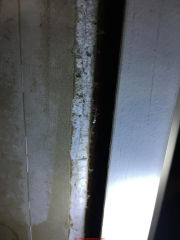 Should I assume type X has asbestos in it?
Should I assume type X has asbestos in it?
The house it is in was built in late 1985 between July and November in California. One of the panels reads Sheetrock Firecode Type "X" Gypsum Panel.
Visible edges of other panels show long straight fiber bundles protruding from the sides.
I understand asbestos was commonly used in the joint compound but also in drywall but it is rare.
Attached is a picture of the edge. [shown above]
Reader Question: found asbestos in popcorn ceiling paint
I wrote you a few years ago asking asbestos questions. Myself and other neighbors foolishly handled asbestos after being told our homes didn't contain asbestos.
Only one neighbor was smart enough to have their popcorn tested and to our shock it contained asbestos.
Anyway, I went and had my house tested. I had a guy come out and looked over the house. While there is asbestos in other places but I know to leave it alone.
You were so helpful and I am so grateful. I am in need of your expertise again.
Years ago I had a company remove my popcorn ceiling from the living room and hallway. When they did the removal some of the tape came off and a few years later I had cracks. I filled the cracks with caulk. When the asbestos inspector came out you couldn't see the cracks. I had forgotten all about them.
The mud used on the drywall tape had asbestos but little right around 1 percent. My ducts/attic didn't have asbestos. The cracks are back and they get larger in the winter. Should I have behind the ceiling or walls tested?
I am concerned that if the ceiling is lined that it would be releasing fibers. Do homes have their drywall lined with asbestos? My house was built in 1976 in California.
I am imagining it would be expensive to have this test. I am a single mom with three kids so I don't have much money to spare.
Your input last time was truly appreciated and helpful. - Anon [by private email 2015/12/24] -
Reply:
My OPINION, based on reading about drywall asbestos hazards (principally in the mud or joint compound) is that the risk from a crack appearing is probably below the limits of asbestos detection indoors in a home.
Proper repairs, so as not to keep seeing cracks, is to use fiberglass mesh drywall tape and modern (non-asbestos) joint compound, feathering out the joint to at least 18", wider is better. Properly taped and compounded and then wet-sanded or sponged the joints will become invisible to the eye even when shining a light along the wall.
The re-paint the repaired walls or ceilings.
I'd like to see photos of the cracks and of any repair you do.
More details are at CEILING PAINT TEXTURED / POPCORN ASBESTOS
and at DRYWALL CRACKS and
also see Steve Bliss's article: DRYWALL INSTALLATION Best Practices
Question: Does this asbestos product from a 1969 home contain asbestos? What percentage of asbestos?
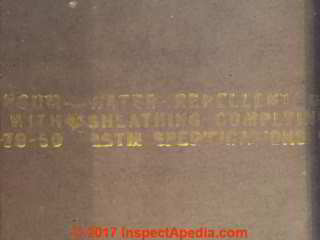 Ran across this in a remodel project. Home was built in ’69. From your website, it seems it contains asbestos, correct? Do you happen to know the percentage? - Anonymous by private email 2017/09/14
Ran across this in a remodel project. Home was built in ’69. From your website, it seems it contains asbestos, correct? Do you happen to know the percentage? - Anonymous by private email 2017/09/14
[Click to enlarge any image] The fraction of yellow text imprinted on this drywall from a U.S. home built in 1969 is given below with [in brackets a guess at missing text]
[U.S. GY ] ... PSUM - WATER-REPELLENT - ?
WITH - SHEATHING COMPLYIN [G WITH ASTM ....]
-79-50 ASTM SPECIFICATIONS [...]
Reply: U.S. Gypsum & Other Drywall / gypsum board from 1920 to at least 1976 often included asbestos -
Thank you for the photo and question, [anonymous]. Yes, some drywall and plaster board products from as early as 1920 and running through as late as 1976 had asbestos added to improve strength and fire-resistance.
In our article SHEATHING, GYPSUM BOARD you will find another and more-complete illustration of the yellow-writing stamped on your gypsum board, from a building in New York State. There we point out that asbestos was used in a number of National Gypsum Gold Bond™ gypsum board products produced between 1950 and 1970.
Asbestos was not used in National Gypsum gypsum-board products after that year. Other gypsum board or "drywall" producing companies produced gypsum board that contained asbestos.
In that article you'll see very similarly-stamped water-resistant gypsum board sheathing stamped as in compliance with ASTM Standard ASTM C79/C79M-04a. According to ASTM, this specification was withdrawn in December 2004 and replaced by Specification C 1396/C 1396M for Gypsum Board.
White chrysotile asbestos fibers and possibly filler paste were added by some manufacturers to plaster that in turn was added to water-resistant and other drywall in order improve the fire resistance of that product.
Some of these products may also contain tremolite (a form of amphibole asbestos) as an inadvertent contaminant from asbestos mining of chrysotile, and also they may include vermiculite that, depending on where it was mined, also contains asbestos (Libby).
There were over thirty such products produced by at least six U.S. manufacturers, so I cannot cite nor have I found a specific asbestos content by percentage for that drywall or tile board or water-resistant tile backer that was used in some bathrooms.
Keep in mind that most sources find the greater levels of asbestos were in joint compound used at joints that were taped, then normally also painted.
If the drywall in your photo is undisturbed by sawing, grinding, chopping etc. then it's very unlikely that any measurable level of asbestos from that source would be detected inside the home you describe.
Still it would be appropriate to warn occupants about proper handling of drywall during any future remodeling or repair efforts.
Near the top of ASBESTOS in DRYWALL we note
In joint compound the asbestos content varied but typically was between 3-6%.
Even if the gypsum board itself did not contain asbestos this means that by weight the asbestos content of the wall system was about 0.25%. (Redmond 2011), "Sheetrock mud" is a synonym for drywall compound or joint compound that before 1978 may have contained asbestos fibers.
Also see ASBESTOS PRODUCING COMPANIES & TRUSTS and
see ASBESTOS LIST of PRODUCTS.
On 2019-12-23 by Diane
Hello I found some the pink joint compound plaster at my house that was built in 1987 and I used it to fix my kids closet. I did sand a bit do I need to worry. It’s the pink compound that turns white when dry! Thank you
On 2019-12-23 by D
Hello i would like to know if the pink joint compound might contain asbestos. We purchased a house built in 1987 and it was at the house when we got it. I used it the fix my kids bedroom closet and did a bit of sanding. I’m scared of the asbestos cancer I heard it’s rare but I don’t know how we are supposed to be careful but not be over stressed at the same time. Thank you for your reply.
On 2019-09-28 by David
Do I need to test for asbestos and lead before cutting a 3 foot square hole in drywall to repair a leaky pipe? The house was built in 1968.
On 2019-09-16 by Vanessa Salas
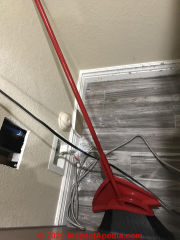 Hello,
Hello,
When I moved into my house our water company cut a small area of drywall behind my refrigerator to access a water line. The cut was the size of an adult hand. I thought he cleaned all the drywall dust but when I moved our fridge yesterday to clean behind it I found drywall dust there.
A lot of it was hard and caked onto along the baseboard but some of the dust was still loose, under the refrigerator. Maybe about a tablespoon worth.
I’m concerned because the refrigerator has a compressor fan behind it that blows air under the fridge and out the bottom front grill. My home was built in 2007 so I know that asbestos is not in the drywall but I read drywall contains silica.
The fridge is in a cut out space with cupboards and walls around it and tge back of the fridge was covered with cardboard that has small slots.
how much silica is inside of drywall dust? If I had to guess how much dust there was behind the fridge (including the hardened dust) I would say it was about 1/4-1/2 cup of it.
My biggest concern is that this stuff has been blowing into my house from the bottom of the fridge for the past year. I have my twin girls in the house and we run the ac a lot. There’s a lot of coils and components under the fridge so I’m hoping some of the dust got stuck in that but if some still came out, what are the risks from this?
Question: I'm so worried about breathing asbestos from drywall that I can't eat or sleep
Sep 19, 2017 Anonymous asked:
I have read extensively through your site and still have some questions (actually opened up more)
Our home is 1984 built. A handyman cut out a section of drywall in bathroom when he removed baseboards that got wet. The baseboards I know are 2002 by previous owner.
The drywall assuming original. Hen it took a few weeks for him to patch the part he cut out and replace baseboards. I am terrified of potential asbestos my kids breathed. I have a company coming to test in a few days.
This research lede to realize from family conversations that when my brother and sister in law remodeled a 1962 house themselves my mom took my kids over there on several occasions during remodel. Not when active sanding going on but work in process.
Am going to have to assume massive asbestos exposure right? They won't agree to any testing at all not will my parents in their 1979 house that my father frequently cuts holes in drywall.
Am I to assume all of these three homes have asbestos?
I am so worried sick I cannot sleep or eat.
Reply: OPINION:
Thank you for the note, Anon,
In our main article on this topic ASBESTOS in DRYWALL - topic home, I express an opinion that to the early 1980's (ca 1982 if we use Canada instead of the U.S.) there could be asbestos in drywall and in joint compound.
In a 1984 home the drywall wouldn't be likely to be an asbestos product, though no one can guarantee that without a number of test of joint compound as well as the board itself, enough to be sure the samples represent the home.
Certainly cutting drywall with a knife to remove wet or damaged sections is a comparably low-dust procedure compared with such work is done by a dope with a power saw. A power saw can make a lot of airborne dust that could well be hazardous to breathe even if it contained no asbestos.
Un-finished drywall work doesn't emit significant dust particles if it's not being disturbed, particularly if decent clean-up was done after cutting and again after taping and sanding (if sanding was even used - I use a wet sponge).
For a 1960's house the assumption that asbestos was present in low levels in the actual drywall and in higher levels in the taping compound is a reasonable one.
I have discussed acute asbestos exposure with several people who recall the most-hazardous work environments such as in the shipbuilding industry where high-asbestos insulating and other materials were used and where at times the air was literally thick opaque with dust that was very high in asbestos.
That extreme condition as well as some industrial jobs in which workers had to labor directly with high concentrations of asbestos and who tracked it home in their clothing, are the highest-risk situations for people. No one in North America is working in such situations now.
I would not assume that you or your kids had a massive asbestos exposure, particularly if you were not there when the air was thick with drywall dust.
Being terribly frightened [about a low-probability of having breathed in drywall dust that might (probably didn't) contain asbestos]) is itself bad for your health.
I hope you'll discuss your worries with your doctor; most likely she'll agree that there is no human testing that's appropriate at this point unless there are specific health complaints that she finds pertinent.
If you decide to have your home tested for asbestos keep in mind where the greater hazards would have been: joint compound that was most likely no longer in use when your home was built. So if someone punches a sample from the center of wallboard they're missing the joint compound.
I'm glad you didn't get dizzy reading our articles and sorry that maybe reading our information made matters worse by raising more questions. But that's why I'm glad you've contacted me - I can try to address your question and also clarify what we've published.
Editor.
On 2017-09-18 by Julie
Hi I am working in a building built in the late 1800- early 1900 in Vt. Renting office space and the hot water radiator steamed a hole into my wall it was fixed fir a long time and I thought nothing if it.
Until it dawned on me there could be asbestos in the wall. Now I am very nervous and don't even use my office. Can you tell me the chances of the wall containing asbestos and or how I can find out fur sure the person I rented from says they don't know! Thank you!
On 2017-09-17 by Angie Stasand
We live in a home built in 1984 in Irvine CA. We had a water leak in bathrooms and had four inches of drywall cut out along wall. I never even thought to have it checked for asbestos now am worried sick about whether it contained. I understand there is now at of knowing without testing. But any idea if the chances would be higher or lower?
How worried should I be?
I mean my brother cuts all intonhisndrywall in home built in 1979 and tells me I being ridiculous.
On 2017-07-09 by (mod) - find out if our fire protective drywall contains asbestos by looking up the 8 digit code
I haven't had success with numeric code lookups, 1973.
I'd treat the drywall as presumed to contain asbestos, though frankly the greater risk will be in the drywall mud not the drywall sheets. That means cutting and removing using minimal dust-making methods, and taking appropriate precautions in both dust control in the building and personal protection.
In my OPINION, demolition dust is bad stuff to breathe in anyway - take it from a really old guy who developed adult onset allergic asthma from just such work.
Or you can search our site for ASBESTOS TEST LABS if you want to have a test performed. You'd need to test the joint mud not just a central section of drywall.
On 2017-07-09 by 1973 house
Is there a way to find out if our fire protective drywall contains asbestos by looking up the 8 digit code printed on the back? Our neighbor, who's house was built within a couple years of ours, found out his place has it in the mud, and we plan to renovate.
On 2017-06-05 by (mod) - Don't panic - but do avoid creating a dusty mess.
Jenni
At a companion article RESILIENT SHEET FLOORING ID GUIDE https://inspectapedia.com/hazmat/Sheet_Flooring_Identification.php we start our article series about asbestos in sheet flooring products.
At ASBESTOS DUCTS, HVAC -https://inspectapedia.com/hazmat/Duct_Asbestos.php we discuss the use of paper both as a joint tape and as a total; covering on heating air ducts in older homes.
Don't panic - but do avoid creating a dusty mess. Or if you have to face a dusty demolition then I'd have the material tested for asbestos
Search InspectApedia for ASBESTOS TEST LABS if you need that service.
Trivial cuts (an installation drill hole) ought never justify expensive asbestos testing and remediation, but even there you could minimize risk by either wetting or more-likely by using a HEPA-rated vacuum for dust control followed by damp wiping cleanup.
On 2017-06-05 by Jenni
We have a 1959 rancher. I know that there is a likelihood of asbestos in areas like sheet vinyl (original) and tape on heating ducts, but until recently I was not aware that it could be in drywall/mud systems. Like many homeowners we have put nails into walls, drilled large holes to anchor our flat-screen television, and more.
Now I am worried we might have contaminated our home by doing so, and yet it seems crazy to think we can't put small holes in our walls. Is it safe to do so?
Also, in the future we would like to add recessed lights and another window to our kitchen (plus a vent pipe opening after we move the stove to that wall). Would we need to have everything tested first, or is it safe to make a few cuts/drills openings into the kitchen wall?
On 2017-05-19 by (mod) - cleaning up dust from an opening in drywall that is just a couple of square inches
Lee
I think you're talking about cleaning up dust from an opening in drywall that is just a couple of square inches. Seems to me that damn wiping will be perfectly sufficient for case like that
See the advice given at ASBESTOS-SUSPECT DRYWALL ENCAPSULATE in PLACE
On 2017-05-19 by Lee
Hi,
We recently purchased a home built in 1976. We have a need to do a small amount of handyman work that requires disturbing it. A towel rod fell out, leaving some crumbling drywall that we want patched up and painted. We also want to have some baby gates installed on the stairwell.
The drywall joint compound probably has asbestos (an asbestos testing company told us ~80% likelihood).
Assuming this is true, do you have any advice on how we do this type of light work that will disturb small amounts of drywall? It seems your typical handyman wouldn't know how to deal with asbestos drywall. Indeed, most contractors that we've talked to so far seem unaware of asbestos joint compound, let alone are trained with how to deal with it.
We were also thinking about adding recessed lighting, but this is a luxury, and might not be worth the complications involved.
On 2017-05-16 by (mod) - pioneer baseboard
Tom,
Asbestos can be present in board-type products both as long fibers and as very short fragments, even dust though the latter was used more-commonly as filler in floor tiles and perhaps in some asbestos-cement board. I'd like to see photos of the material you describe - our email is at the page top/bottom CONTACT link.
Keep in mind that if the material you have is gypsum board ("drywall"), the asbestos hazard is more likely to be in joint compound used on taped joints.
On 2017-05-16 by Tom
I am currently removing ceilings in a house! The board is pioneer baseboard and it looks quite modern although there are fibres within the board. Will this be asbestos or another form of fibres like glass wool? I am not sure of the age of the board but the house is 1930s.
Thanks in advance for your help.
Tom
On 2017-05-11 by (mod) - Were there any drywall finishing compounds that didn't contain asbestos in the 70's?
Curious
It's a fair question and not one for which I've been able to find authoritative research that gives an answer. Let's both try Google and Google Scholr and Patent Research to see if we can find a better answer.
On 2017-05-11 by Curious
Were there any drywall finishing compounds that didn't contain asbestos in the 70's? If so, what percentage of compound on the market then didn't use it? My house was built in 1976 and this seems to be a pretty big problem.
On 2017-04-29 by (mod) -
YOu can use the page top or bottom CONTACT link to send us photos for comment, Kimberly. The Comments box code doesn't allow links or photos - to avoid possible malware. Sorry.
Maybe just damp wipe exposed surfaces.
On 2017-04-28 by Kimberly
It's specifically the ducts running in and out of the ventilation unit. The insulation was sticking out of the black sleeving around the ducts. It's since been taped so none seems to be exposed. It's in a living area/spare room. There are many shiny fibers on the unit and the sleeving. I'm not sure if there is a way to put a picture up and better describe
On 2017-04-28 by (mod) -
Surely the fiberglass insulation on a vent is not in the living space, right? If it's in a ceiling or wall that's closed, sealed, covered-up you should be ok.
On 2017-04-28 by Kimberly
Thank you for your prompt reply. I've taped over the couple edges where it was exposed and coming apart. One more question, regarding my new home. We have a Venmar Constructo (2.0?) ventilation unit in one of our storage rooms that we intend to put kitchen supplies etc.
It has a few metal ducts/pipes connecting it to everything and they're covered in a black sleeve filled with insulation. At our request, the landlord taped up all the joints because it had tons of insulation sticking out. Now the unit and on the black sleaving there appears to be dozens if not 100+ small tiny fibers all over it.
Again, I'm assuming fiberglass. What is the best method of cleaning this up? How hazardous is this actually? I'm afraid I can't vacuum it because it'll grab the black sleeving in and rip it, creating a more serious problem. And it's like loose plastic wrap around the duct, so wiping it is difficult. Would something like a swiffer duster be wise, or would it just spread it around?
On 2016-11-06 by Dennis
I've decided to stop dancing around the issue and get it tested. -:)
I have contacted two asbestos remediators who work in the area. They told me there's definitely no asbestos in the insulation.
Definitely no asbestos in the sheetrock. But they were certain there was asbestos in the seam compound.
About 150 to 250 sq ft of wall was ripped out. Is this serious enough that I should consider not buying the house or can it be cleaned up safely?
On 2016-11-05 by (mod) re: asbestos in drywall?
Dennis, I can't guess if your home has an asbestos hazard or not - by e-text. But to allay concern it'd be reasonable to collect some settled-dust samples that represent indoor conditions and have those examined by a certified asbestos test lab
Search InspectApedia using the box just above, to fine ASBESTOS TEST LABS and for a simple inexpensive dust sample collection method search for DUST SAMPLE COLLECTION
On 2016-11-04 by Dennis
Not sure my post below is very clear. It's already done.They tore down the walls that had asbestos in the float compound and did nothing about containing it. Now I'm concerned about asbestos particles in the home, about a year-and-a-half later 1. is it serious? 2.what should I do?
I apologize if this is a double post.
I'm buying a 1979 home where the homeowners did some renovation in the kitchen. They removed a few walls. No concern for the asbestos in the tape compound. A few years later, how much concern should I have for asbestos dust? Options?
On 2016-10-25 by (mod) re: reducing asbestos hazard in joint compound by paint, wallpaper, or laminated overlayers of gypsum board or paneling
Sure: even paint, wallpaper, or a laminate layer of 3/16" gypsum board or paneling reduce the remaining asbestos hazard to trivial (though not to absolute zero, as somebody drilling ito a wall can create a bit of dust).Most expert sources such as the US EPA advise that the best approach to most asbestos materials is to leave them alone and in place, covering over the surfaces involved. Only when material is soft, friable, damaged, or in an area subject to damage and subject to dispersal of asbestos debris in occupied space does removal or other more expert encapsulation come to be urgent.
On 2016-10-25 by doug
thank you, this can make life a lot simpler, to ensure a safe living environment, that any potential asbestos products in the wall or wall surface, can be covered with a layer of gypsum to ensure a safe living environment for renters.On 2016-10-24 by (mod) re: cover drywall taping areas to reduce asbestos worry
In general if you cover drywall or taping compound and leave it undisturbed I think there will be no measurable airborne asbestos levels traceable to that source.On 2016-10-24 by doug
if there is suspected asbestos in the drywall compound, and in an insulation board behind the sheetrock,
1; is a durable paint over the wall surface good enough to seal any possible containing plaster compounds.
2; will applying a layer of plaster over the entire surface and then painting be sufficient to seal any asbestos product.
3; or simply applying another layer of gypsum board, plaster and paint and seal all electrical outlets and other protrusions be more than sufficient if asbestos is suspected because of the age of the home.
your comments on the 3 questions much appreciated, thank you, doug
On 2016-10-10 by (mod) re: New York City drywall classification specifications
This is indeed an NYC drywall classification elaborated as:DRY WALL CONSTRUCTION TYPE X AS PER B. S. & A., CAL. NO. 301-60 6. S.M. MOISTURE RESISTANT GYPSUM WALLBOARD AS PER B.S. & A., CAL NO. 486-39 S.M. MASTIC ADHESIVE FOR WALL TILE AS PER B.S. & A., CAL. NO. 748-41 S.M. & CAL. NO. 518-60 S.M
In some job and project specifications. As best I can determine there was a standard (not found online) for moisture-resistant drywall using that number.
While asbestos was used in some drywall, sheetrock or more properly "gypsum board products, the greater hazard is likely to be in the taping or joint compound.
On 2016-10-10 by (mod) re: Approved by the board of standards and appeals for use in New York City Under Calendar No. 486-39-SM
Following question received by private email, sender kept anonymous:
We are seeing sheet rock in a few places in the basement (built 1965) that has a stamp on it reading "Approved by the board of standards andappeals for use in New York City Under Calendar No. 486-39-SM."
Are
you familiar with the meaning of that stamp? Any guesses on the odds
the sheet rock contains asbestos?
On 2016-08-08 by (mod) re: repairing drywall damage before painting
Dan:I suggest covering the damaged area with joint compound or spackling compound or a product like Dash Patch before painting.
Even if the area exposed an asbestos-containing substrate, I doubt that there would be a measurable airborne asbestos level from a roughly 2x2" exposure of otherwise undisturbed surface.
On 2016-08-08 by Dan
Sorry for double-posting. But for added clarification, the property was built in 1905 with no major renovations listed since. What are the chances of the drywall (not piping insulation, boiler insulation, etc) containing asbestos?Recently removed something I had hanging on my wall that was attached with a strong, double sided adhesive tape. During removal it took with it the outer layer of the wall. I'm not sure if the wall is plaster or drywall construction.
What is underneath looks like stone, and does not appear to be hairy like some asbestos is. What I want to know is that if it is asbestos, is it dangerous to leave it there? I haven't gotten the wall repaired for more than a month, and only started concerning myself recently of whether or not it contained asbestos. The tear/ripped area is pretty high, and I generally have a ceiling fan running.
Also, what kind of repair should I get?
Thanks.
On 2016-06-15 by (mod) re: What variety of asbestos was used in drywall, Chrisotile or amphibol
Anon:
To permit space for a detailed reply and to include research citations we repeat your question and give a detailed answer in ASBESTOS in DRYWALL.
The short answer is both Chrisotile and Amphibole asbestos were used in some drywall or gypsum board products, though primarily Chrisotile asbestos.
On 2016-06-14 by Anonymous
What variety of asbestos was used in drywall, Chrisotile or amphibole?
Question: Asbestos used in Faspite gypsumplaster or Pioneer Insulated Baseboard produced at Billingham by ICI ?
2016/05/12 TRM said:
We have building built in 1961. The plaster work is 1 "Faspite" gypsum plaster manufactured by the Billing ham division of ICI 2 "Pioneer" insulated baseboard made by the same firm. Do these contain asbestos?
[This question was posted originally
at ASBESTOS PHOTO GUIDE to MATERIALS]
Reply:
Thanks for the question TRM. Faspite is not a product with which we're familiar, nor is Pioneer insulated wallboard.
Please use the page top or bottom CONTACT link to send me photos of your plasterboard or insulating board along with any identifying markings on it as that will help us research further.
In this article (above on this page) you'll see a discussion of asbestos in drywall along with links to articles offering more detail on that hazard. Please check those out. Especially, see inspectapedia.com/hazmat/Asbestos_in_Drywall.php where we will re-post your question along with any further research results.
Our research to date has found that the principal source of asbestos in wallboard products has been in joint compound used to tape and seal the abutting joints of drywall or gypsum board. The plethora of mesothelioma lawsuit websites who list information on asbestos in drywall seem to confuse the joint compound source of asbestos with the drywall product itself.
Though of course we can't absolutely rule out asbestos in some gyp-board or drywall products, that source makes little appearance in the literature we've found to date. More information is in the REFERENCES section of this article.
I'll do a bit more research and add remarks here. Tell me if you are asking about a U.K. product or if you're located elsewhere.
Gypsum plasterboard was indeed manufactured by ICI in the early 1960's and marked as you describe 1 Faspite gypsum plaster, produced by Billingham division of ICI and Pioneer insulated board as well.
ICI was a British conglomerate - ICI History
According to Encyclopedia.com, ICI was a British conglomerate that produced chemicals and industrial products and that was Britain's second-largest wallboard producer until 1967. British Plaster Board, BPB plc, now a wholly-owned subsidiary of Saint Gobain Inc. (http://www.bpb.com) bought Bellrock Gypsum in that year (1967). By the end of 1968 ICI had given up its wallboard producing machinery to BPB, giving that company a virtual monopoly on gypsum board production.
...
Continue reading at ASBESTOS in DRYWALL - topic home, or select a topic from the closely-related articles below, or see the complete ARTICLE INDEX.
Also see ASBESTOS in DRYWALL FAQs-2 - more questions and answers about the asbestos content in drywall and drywall compound.
Or see these
Recommended Articles
- ASBESTOS CEMENT CEILING & WALL PANELS
- ASBESTOS in DRYWALL
- ASBESTOS-DRYWALL REMEDIATION / REMOVAL
- ASBESTOS IDENTIFICATION IN BUILDINGS
- ASBESTOS LIST of PRODUCTS
- ASBESTOS in PLASTER - what about the use of asbestos in plaster walls & ceilings?
Suggested citation for this web page
ASBESTOS in DRYWALL FAQs at InspectApedia.com - online encyclopedia of building & environmental inspection, testing, diagnosis, repair, & problem prevention advice.
Or see this
INDEX to RELATED ARTICLES: ARTICLE INDEX to ASBESTOS HAZARDS
Or use the SEARCH BOX found below to Ask a Question or Search InspectApedia
Ask a Question or Search InspectApedia
Try the search box just below, or if you prefer, post a question or comment in the Comments box below and we will respond promptly.
Search the InspectApedia website
Note: appearance of your Comment below may be delayed: if your comment contains an image, photograph, web link, or text that looks to the software as if it might be a web link, your posting will appear after it has been approved by a moderator. Apologies for the delay.
Only one image can be added per comment but you can post as many comments, and therefore images, as you like.
You will not receive a notification when a response to your question has been posted.
Please bookmark this page to make it easy for you to check back for our response.
IF above you see "Comment Form is loading comments..." then COMMENT BOX - countable.ca / bawkbox.com IS NOT WORKING.
In any case you are welcome to send an email directly to us at InspectApedia.com at editor@inspectApedia.com
We'll reply to you directly. Please help us help you by noting, in your email, the URL of the InspectApedia page where you wanted to comment.
Citations & References
In addition to any citations in the article above, a full list is available on request.
- In addition to citations & references found in this article, see the research citations given at the end of the related articles found at our suggested
CONTINUE READING or RECOMMENDED ARTICLES.
- Carson, Dunlop & Associates Ltd., 120 Carlton Street Suite 407, Toronto ON M5A 4K2. Tel: (416) 964-9415 1-800-268-7070 Email: info@carsondunlop.com. Alan Carson is a past president of ASHI, the American Society of Home Inspectors.
Thanks to Alan Carson and Bob Dunlop, for permission for InspectAPedia to use text excerpts from The HOME REFERENCE BOOK - the Encyclopedia of Homes and to use illustrations from The ILLUSTRATED HOME .
Carson Dunlop Associates provides extensive home inspection education and report writing material. In gratitude we provide links to tsome Carson Dunlop Associates products and services.



